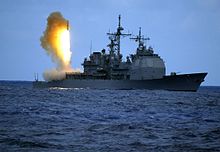- Space weapon
-
Space weapons are weapons used in space warfare. They include weapons that can attack space systems in orbit (i.e. anti-satellite weapons), attack targets on the earth from space or disable missiles travelling through space. In the course of the militarisation of space, such weapons were developed mainly by the contesting superpowers during the Cold War, and some remain under development today. Space weapons are also a central theme in military science fiction and sci-fi video games.
Contents
Space to Space weapons
The Soviet Almaz secret military space station program was equipped with a fixed 23mm autocannon to prevent hostile interception or boarding by American forces.
The Soviet unmanned Polyus weapons platform was designed to be equipped with a megawatt carbon-dioxide laser.
Earth to Space weapons
 The Aegis Ballistic Missile Defense System. A RIM-161 Standard Missile 3 anti-ballistic missile is launched from USS Shiloh, a US Navy Ticonderoga-class cruiser.
The Aegis Ballistic Missile Defense System. A RIM-161 Standard Missile 3 anti-ballistic missile is launched from USS Shiloh, a US Navy Ticonderoga-class cruiser.
Anti-satellite weapons, which are primarily surface-to-space and air-to-space missiles, have been developed by the United States, the USSR/Russia, and the People's Republic of China. Some test firings have been successful in destroying orbiting satellites.
In general use of explosive and kinetic kill systems is limited to relatively low altitude due to space debris issues and so as to avoid triggering the Kessler syndrome.
Strategic Defense Initiative
Main article: Strategic Defense InitiativeOn March 23, 1983, President Ronald Reagan proposed the Strategic Defense Initiative, a research program with a goal of developing a defensive system which would destroy enemy ICBMs. The defensive system was nicknamed Star Wars, after the movie, by its detractors. Some concepts of the system included Brilliant Pebbles, which were Kinetic Kill Vehicles, essentially small rockets launched from satellites toward their targets (a warhead, warhead bus, or even an upper stage of an ICBM. Other aspects included satellites in orbit carrying powerful lasers or particle beams. When a missile launch was detected, the satellite would fire at the missile (or warheads) and destroy it. Although no real hardware was ever manufactured for deployment (according to public knowledge), today the military is testing the use of lasers mounted on Boeing 747s to destroy missiles. The tests are taking place at Edwards Air Force Base.
Space to Earth weapons
Orbital weaponry
Orbital weaponry is any weapon that is in orbit around a large body such as a planet or moon. As of 2010, there are no known operative orbital weapons systems, but several were designed by the United States and the Soviet Union during the Cold War. During World War II Nazi Germany also was developing plans for an orbital weapon called the Sun gun.[1]
Development of orbital weaponry was largely halted after the entry into force of the Outer Space Treaty and the SALT II treaty. These agreements prohibit weapons of mass destruction from being placed in space. As other weapons exist, notably those using kinetic bombardment, that would not violate these treaties, some private groups and government officials have proposed a Space Preservation Treaty which would ban the placement of any weaponry in outer space.
Orbital bombardment
Orbital bombardment is the act of attacking targets on a planet, moon or other such object from orbit around the object, rather than from an aircraft, or a platform beyond orbit. It is most often encountered in fiction, but has been proposed as a means of attack for several real-world weapons systems concepts, including kinetic bombardment and as a nuclear delivery system.
During the Cold War, the Soviet Union deployed a Fractional Orbital Bombardment System from 1968 to 1983. Using this system, a nuclear warhead could be placed in low Earth orbit, and later de-orbited to hit any location on the Earth's surface. While the Soviet Union deployed a working version of the system, they were forbidden by the Outer Space Treaty to place live warheads in space. The fractional orbital bombardment system was phased out in January 1983 in compliance with the SALT II treaty of 1979, which, among other things, prohibited the deployment of systems capable of placing weapons of mass destruction in such a partial orbit.
Orbital bombardment systems with conventional warheads are permitted under the terms of SALT II. Some of the proposed systems rely on large tungsten carbide/uranium cermet rods dropped from orbit and depend on kinetic energy, rather than explosives, but their mass makes them prohibitively difficult to transport to orbit,[2] and their effectiveness has not been proven.[citation needed]
In fiction
Main article: Space warfare in fictionFictional or real space weapons in various forms are often prominently featured in science fiction, particularly in military science fiction and in video games with a sci-fi theme.
References
- ^ Science: Sun Gun. Time Magazine. July 9, 1945. http://www.time.com/time/magazine/article/0,9171,852344-1,00.html.
- ^ R.L. (2008). "Review and Assessment of select US Space Security Technology Proposals". Space Policy 24 (4): 208–223. doi:10.1016/j.spacepol.2008.09.007.
External links
- Nuclear Files.org Basic facts and issues regarding space weapons
- SpaceDebate.org - collection of articles, quotes, and links on the debate over space weapons
Categories:- Space warfare in fiction
- Space weapons
Wikimedia Foundation. 2010.

